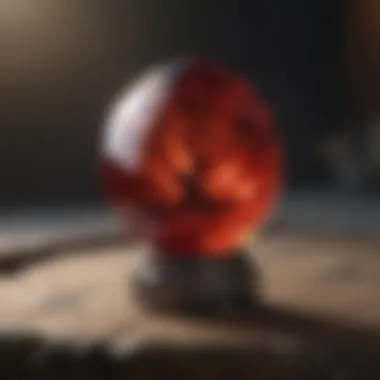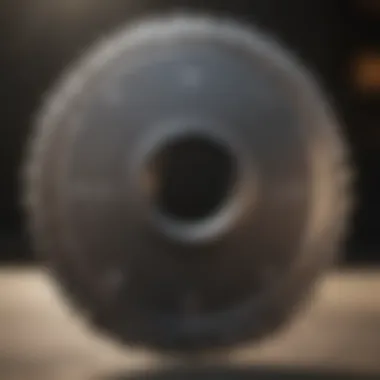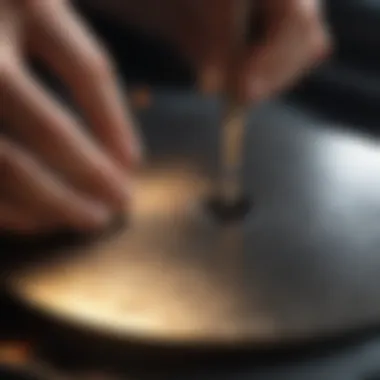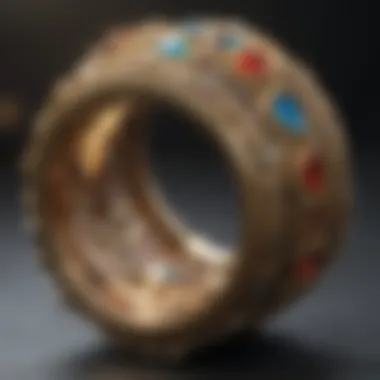Unveiling the Art of Precision: Mastering Stone Cutting Tools for Exquisite Jewelry


Stone cutting tools play a crucial role in the meticulous art of jewelry making. Crafting exquisite gemstones requires precision, skill, and the use of the right tools. From diamond saw blades that cut with ultimate finesse to polishing discs that add the perfect finish, each instrument contributes uniquely to the creation of stunning jewelry pieces.
Rock and Fossil Identification
In the realm of jewelry making, appreciation for the origins of gemstones is fundamental. Understanding the types of rocks and fossils these gemstones are derived from provides jewelers with a deeper connection to their craft. By recognizing the distinct characteristics to look for in each rock or fossil, artisans can enhance their designs with a valuable insight into the materials they work with. Utilizing specialized tools for identification further refines a jeweler's ability to select and shape gemstones effectively.
Collecting Tips and Techniques
Beyond the confines of a workshop, rock and fossil collectors venture into the field in pursuit of raw materials for jewelry making. Best practices for collecting these natural treasures involve meticulous attention to detail and respect for the environment. Locating prime collecting sites requires a keen eye for geological anomalies and potential gemstone deposits. Safely extracting specimens from their geological setting ensures that these precious materials can be transformed into exquisite jewelry pieces without compromising their integrity.
Preservation and Display
Preserving the beauty and durability of gemstones is a crucial aspect of the jewelry-making process. Techniques such as cleaning, sealing, and storing rocks and fossils help maintain their quality over time. Proper storage methods, including the use of archival containers and protective padding, prevent damage and ensure that these materials retain their appeal for years to come. Creative display ideas allow jewelers to showcase their creations in innovative and visually captivating ways, enhancing the allure of their jewelry collections.
Geological Insights
Geological knowledge enriches the journey of jewelry making by shedding light on the natural processes that have shaped the earth over millennia. Exploring geological formations and understanding the forces that have molded rocks and fossils provide a deeper appreciation for the materials used in jewelry crafting. Delving into the historical significance of specific gemstones adds a layer of intrigue to jewelry pieces, connecting wearers to ancient cultures and geological events. Notable discoveries in the field of geology inspire jewelers to push the boundaries of creativity and innovation, infusing their designs with profound insights into the Earth's intricate history.
Introduction
Understanding the Significance of Stone Cutting Tools
The Artistry Behind Jewelry Making
Delving into the artistry behind jewelry making unveils a realm where creativity meets craftsmanship in a harmonious dance. The ability to transform raw gemstones into wearable art requires a keen eye for detail and a deep understanding of the intrinsic beauty hidden within each stone. The artistry behind jewelry making not only celebrates tradition but also paves the way for innovative designs that resonate with connoisseurs around the world. Its fusion of creativity and precision sets the foundation for the elegance that adorns every piece of jewelry, making it a quintessential element in this narrative.
The Impact of Precision in Stone Cutting
Precision in stone cutting serves as the cornerstone of jewelry making, where each incision and facet are meticulously crafted to enhance the splendor of gemstones. The marriage of precision and artistry elevates a simple stone into a radiant masterpiece, captivating the beholder with its brilliance. The impact of precision goes beyond aesthetics, reflecting a dedication to perfection that sets apart true artisans in the realm of jewelry making. Embracing precision not only ensures impeccable design but also guarantees the longevity and value of the final piece, making it a non-negotiable aspect in the pursuit of excellence.
Overview of Key Tools
Diamond Saw Blades
Diamond saw blades represent the pinnacle of stone cutting tools, revered for their unparalleled cutting precision and durability. These blades harness the strength of diamond particles to slice through even the toughest gemstones with ease, making them a popular choice among jewelry makers. The unique feature of diamond saw blades lies in their ability to maintain sharpness for prolonged periods, allowing for intricate cuts that define the beauty of each gemstone. While their advantages are unquestionable, limitations such as cost and specialized maintenance highlight the need for careful consideration when using diamond saw blades.
Grinding Wheels
Grinding wheels play a vital role in shaping gemstones, offering a versatile tool for achieving different contours and finishes. From silicon carbide wheels to diamond grinding wheels, each type brings a distinctive quality to the stone cutting process. The key characteristic of grinding wheels lies in their ability to refine edges and shapes with precision, transforming rough stones into polished gems. However, the choice of grinding wheel must align with the type of stone being worked on, as mismatched tools can result in damage or imperfections.
Polishing Discs
Polishing discs are essential for adding the final touch of brilliance to gemstones, enhancing their luster and allure. With varieties like diamond polishing pads and cerium oxide polishing wheels, these discs offer diverse techniques for achieving different finishes. The key characteristic of polishing discs is their ability to bring out the natural beauty of each gemstone, creating a mirror-like shine that mesmerizes onlookers. While polishing discs are instrumental in elevating the aesthetic appeal of jewelry pieces, they require skillful handling to avoid over-polishing or damaging the stone's surface.
Faceting Machines
Faceting machines revolutionize the art of stone cutting, providing a systematic approach to creating intricate facets and designs with precision. Equipped with features like angle control systems and water cooling mechanisms, these machines offer a controlled environment for cutting gemstones. The unique feature of faceting machines lies in their ability to replicate classic cuts like the brilliant, princess, and emerald cuts with utmost accuracy. While these machines streamline the cutting process, they demand a deep understanding of gemstone properties and cutting techniques to harness their full potential.


Diamond Saw Blades
Diamond saw blades are an essential component in the realm of stone cutting tools for jewelry making, playing a pivotal role in shaping and cutting gemstones with precision. These tools are specifically designed to meet the demands of intricate jewelry crafting, ensuring optimal results in the creation of stunning pieces.
Types of Diamond Saw Blades
Sintered Diamond Blades
Sintered diamond blades are renowned for their durability and efficiency in cutting through tough materials. Their unique design involves a combination of diamond segments and metal powders that are sintered together under high heat and pressure. This results in a tough and long-lasting blade capable of handling various gemstones with ease. The sintered construction provides excellent cutting performance and ensures a smooth finish, making them a popular choice among jewelry makers for intricate cuts and designs.
Electroplated Diamond Blades
Electroplated diamond blades feature a single layer of diamonds attached to the blade's surface through electroplating. This design allows for a more precise and delicate cutting experience, ideal for intricate or fragile gemstones. The electroplated coating provides a sharp cutting edge, making these blades suitable for detailed work that requires finesse and accuracy. However, due to the nature of the electroplating process, these blades may have a shorter lifespan compared to other types.
Segmented Diamond Blades
Segmented diamond blades are characterized by their outward appearance, featuring gapped segments along the edge of the blade. These gaps aid in cooling the blade during operation and allow for quicker debris removal, enhancing efficiency and cutting speed. Segmented blades are versatile and suitable for cutting a wide range of gemstones, providing a balance between speed and precision. They are a popular choice for professionals who prioritize performance and adaptability in their cutting tools.
Choosing the Right Blade for Specific Gemstones
Diamond Blades for Hard Stones
Diamond blades designed for hard stones are engineered to withstand the rigors of cutting through dense and abrasive materials like granite or corundum. These blades feature a high concentration of diamonds embedded in a tough bond matrix, ensuring longevity and stability during the cutting process. Their ability to maintain sharpness and precision makes them ideal for achieving detailed cuts on challenging gemstones while ensuring a smooth and clean finish.
Diamond Blades for Soft Stones
Diamond blades tailored for soft stones prioritize precision and finesse in cutting materials such as talc or fluorite. These blades are crafted with a softer bond matrix to prevent chipping or damage to delicate gemstones during cutting. The fine distribution of diamonds on the blade allows for gentle yet efficient cutting, ensuring minimal waste and a polished edge on softer materials. Jewelry makers prefer these blades for intricate carving or shaping of softer gemstones to achieve refined and intricate designs.
Grinding Wheels
Grinding wheels play a crucial role in the realm of stone cutting tools for jewelry making. They are essential for shaping and refining gemstones with precision and accuracy. The choice of grinding wheels can significantly impact the final outcome of the jewelry piece, emphasizing the importance of selecting the right type for each specific task. In this article, we will explore the key elements, benefits, and considerations surrounding grinding wheels.
Types of Grinding Wheels
Silicon Carbide Wheels
Silicon carbide wheels are known for their durability and efficiency in grinding various types of gemstones. Their ability to maintain sharpness over time makes them a popular choice among jewelry makers looking to achieve precise cuts and finishes. The unique feature of silicon carbide wheels lies in their abrasive properties, allowing for effective material removal while minimizing heat generation. This characteristic ensures that gemstones retain their integrity during the cutting process. Despite their numerous advantages, silicon carbide wheels can be more susceptible to breakage compared to other types of grinding wheels, requiring careful handling and usage.
Diamond Grinding Wheels
Diamond grinding wheels are prized for their superior hardness and longevity, making them ideal for grinding hard materials like gemstones. Their exceptional abrasive strength enables them to withstand high heat levels generated during prolonged use, ensuring consistent performance throughout the stone cutting process. The key characteristic of diamond grinding wheels lies in their ability to maintain sharpness even after extensive use, providing precision cuts and polished finishes. While diamond grinding wheels offer unparalleled efficiency, they can be relatively more expensive than other types of grinding wheels, making them a premium choice for jewelry makers seeking top-tier results.
Resin Bonded Wheels
Resin bonded wheels are known for their versatility and adaptability to a wide range of gemstones. Their composition of synthetic resins bonded with abrasive materials enhances their cutting efficiency and effectiveness. The key characteristic of resin bonded wheels is their ability to produce smooth finishes and intricate designs on gemstones, making them a favored option for detailed jewelry work. Despite their flexibility, resin bonded wheels may exhibit a lower level of durability compared to diamond grinding wheels, requiring periodic replacement to maintain optimal cutting performance.
Grinding Techniques for Different Stone Types


Agate and Quartz
When working with agate and quartz gemstones, precision and finesse are paramount. Their intricate composition demands gentle grinding techniques to prevent fractures or damage. Jewelry makers often opt for finer grit sizes and slower speeds when using grinding wheels on agate and quartz to achieve polished and flawless surfaces. The unique feature of agate and quartz lies in their resilience to heat, allowing for prolonged grinding sessions without compromising the gemstones' structural integrity.
Jade and Opal
Jade and opal gemstones present a distinct challenge due to their varying degrees of hardness and susceptibility to cracking. Jewelry makers must exercise caution when grinding these stones, utilizing specialized wheels with controlled abrasive properties. The key characteristic of jade and opal lies in their delicate nature, requiring precise grinding techniques to enhance their natural beauty and luster. Despite their exquisite appearance, these gemstones demand meticulous grinding practices to avoid irreversible damage.
Ruby and Sapphire
Ruby and sapphire gemstones are renowned for their brilliance and resilience, making them popular choices in jewelry making. Grinding these precious stones requires wheels with high abrasion resistance and precision. The unique feature of ruby and sapphire lies in their hardness, necessitating durable grinding wheels to cut through their tough surfaces effectively. Jewelry makers often employ finer grit sizes and a steady hand to achieve the desired facets and finishes on these exquisite gemstones, showcasing their vibrant colors and exceptional clarity.
Polishing Discs
Polishing discs play a crucial role in the process of refining gemstones for jewelry making, serving as the final touch to achieve a flawless finish that enhances the beauty of the stones. These discs come in various types, each tailored for specific purposes to provide the desired smoothness and polish. Understanding the significance of polishing discs is essential in optimizing the stone cutting process, as they contribute significantly to the overall quality and appearance of the final jewelry pieces.
Varieties of Polishing Discs
Diamond Polishing Pads
Diamond polishing pads are known for their exceptional ability to deliver a high level of shine and polish to gemstones. They are widely used due to their durability and efficiency in achieving a mirror-like finish on various types of stones. The key characteristic of diamond polishing pads lies in their diamond abrasive material, which ensures precision and consistency in polishing. One of the main advantages of diamond polishing pads is their versatility, making them a popular choice for both professional jewelers and hobbyists alike.
Cerium Oxide Polishing Wheels
Cerium oxide polishing wheels are renowned for their effectiveness in polishing glass, stones, and ceramics. The key characteristic of cerium oxide polishing wheels is their abrasive particles that provide a fine polishing action, resulting in a smooth and lustrous finish on gemstones. One unique feature of cerium oxide is its ability to remove scratches efficiently while producing a highly reflective surface. Despite their exceptional polishing capabilities, cerium oxide wheels require careful handling due to their caustic nature.
Alumina Polishing Discs
Alumina polishing discs are favored for their versatility and compatibility with a wide range of gemstones. The key characteristic of alumina polishing discs is their abrasive composition, which allows for effective material removal and polishing. Alumina discs are known for their long-lasting performance and are a beneficial choice for jewelry makers seeking consistency and precision in achieving a desired finish. Their unique feature lies in their ability to adapt to different stone types, making them a practical option for various jewelry making projects.
Techniques for Achieving Different Finishes
Mirror Finish
The mirror finish technique involves using fine abrasives to create a smooth and reflective surface on gemstones. This finish is characterized by its flawless and reflective appearance, enhancing the stone's visual appeal. The key characteristic of a mirror finish is its ability to highlight the gemstone's clarity and color, making it a popular choice for showcasing the stone's natural beauty. While a mirror finish provides a stunning visual effect, it requires precise execution to avoid imperfections such as scratches or uneven surfaces.
Matte Finish
A matte finish technique involves creating a non-reflective surface on gemstones, giving them a soft and elegant appearance. The key characteristic of a matte finish is its satin-like texture, which adds a subtle sophistication to jewelry pieces. Matte finishes are popular for their modern and understated look, making them a versatile choice for both contemporary and classic designs. One unique feature of matte finishes is their ability to mask imperfections in the stone, providing a smooth and uniform appearance.
Textured Finish
Textured finishes involve creating patterns or embellishments on gemstones to add depth and dimension to jewelry pieces. The key characteristic of a textured finish is its tactile quality, offering a sensory experience beyond visual aesthetics. Textured finishes provide a whimsical and personalized touch to jewelry, making each piece unique and distinctive. While textured finishes offer creative freedom in design, they require skill and precision to execute intricate patterns effectively, ensuring a cohesive and artistically expressive result.
Faceting Machines
Faceting machines play a crucial role in the realm of stone cutting tools for jewelry making. These machines are essential for achieving precision cuts and intricate designs on gemstones. Their significance lies in their ability to control angles, shapes, and facets with utmost accuracy, ultimately enhancing the overall quality of the finished jewelry pieces.


Features and Functions of Faceting Machines
Angle Control Systems
Angle control systems are a fundamental component of faceting machines, allowing artisans to adjust the angles at which stones are cut. This feature is pivotal in ensuring the precise alignment of facets on gemstones, contributing to the brilliance and symmetry of the final product. The versatility and adjustability of angle control systems make them a popular choice among jewelry makers aiming for perfection in their creations. However, one drawback of this system may be its complexity, requiring users to have a deep understanding of how different angles impact the overall appearance of the gemstone.
Dop Sticks and Transfer Fixtures
Dop sticks and transfer fixtures play a crucial role in securing and manipulating gemstones during the cutting process. These tools help jewelers position and rotate stones accurately for facet alignment. Their unique feature lies in their ability to hold gemstones firmly in place, allowing for precise cuts and facets. While dop sticks and transfer fixtures offer stability and control, some artisans may find them time-consuming to set up and adjust, particularly when working with intricate designs or delicate stones.
Water Cooling Systems
Water cooling systems are designed to prevent overheating of gemstones during the cutting and shaping process. By circulating cool water around the cutting area, these systems protect the stones from damage due to excessive heat generated by the friction of the cutting tools. The key advantage of water cooling systems is their efficiency in preserving the integrity of gemstones, especially when working with heat-sensitive materials. However, the use of water cooling systems may pose challenges in terms of maintenance and monitoring water levels to ensure continuous operation without compromising the cutting quality.
Optimizing Faceting Machines for Different Cuts
Brilliant Cut
The brilliant cut is a popular choice for maximizing the brilliance and fire of gemstones, emphasizing light reflection and dispersion. This cut features multiple facets strategically positioned to enhance the gem's sparkle and scintillation. Its unique feature lies in its ability to transform even the dullest stone into a dazzling masterpiece. While the brilliant cut offers unparalleled brilliance, some artisans may find it challenging to execute due to its intricate facet arrangement requiring meticulous precision.
Princess Cut
The princess cut is renowned for its modern yet elegant appearance, showcasing a square or rectangular shape with brilliant faceting. This cut's key characteristic is its versatility, as it suits various gemstones and jewelry styles, adding a touch of sophistication to any design. The princess cut's unique feature lies in its ability to combine the brilliance of a round-cut diamond with a contemporary geometric shape. Despite its popularity, achieving a flawless princess cut requires expertise and attention to detail to ensure symmetrical facets and sharp corners.
Emerald Cut
The emerald cut is celebrated for its elongated rectangular shape and step-cut facets that highlight the clarity and color of gemstones. This cut's key characteristic is its emphasis on the gem's clarity and depth, making it an excellent choice for showcasing transparent stones like emeralds and diamonds. The unique feature of the emerald cut is its ability to exude sophistication and understated elegance, making it a timeless classic in the world of jewelry making. However, artisans may face challenges in achieving the precise step cuts and maintaining symmetry across the gemstone, requiring patience and skill to master this cut.
Conclusion
In the intricate realm of jewelry-making, optimizing stone cutting tools is paramount for creating exquisite pieces that stand out in both craftsmanship and quality. As the heartbeat of this article, the Conclusion serves as the pinnacle of wisdom and guidance for rock and fossil collectors looking to elevate their artistry. It encapsulates the significance of selecting the right tools and techniques, weaving a tapestry of innovation and precision.
The key elements highlighted in this article revolve around the thoughtful selection of tools such as diamond saw blades and polishing discs, each playing a crucial role in the creation process. Understanding the nuances of these tools can truly transform a piece of rock into a masterpiece of fine jewelry. By embracing the concepts discussed, artisans can imbue their creations with a level of quality and detail that sets them apart from the rest.
Moreover, the Conclusion expounds on the importance of constant learning and experimentation. By continually refining techniques and exploring innovative approaches to stone cutting, craftsmen can push the boundaries of their craft, creating jewelry that resonates with both beauty and originality. The Conclusion of this article acts as a beacon of inspiration, encouraging artisans to strive for excellence and embrace the evolving landscape of jewelry-making.
Elevating Your Jewelry Making Craft
Embracing Precision and Quality
Embracing Precision and Quality stands as a cornerstone in the art of jewelry-making, elevating pieces from mere trinkets to timeless works of art. This specific aspect delves deep into the meticulous attention to detail required in every cut and facet, underscoring the importance of precision in creating flawless gemstones.
The key characteristic of Embracing Precision and Quality lies in its ability to transform raw materials into breathtaking pieces through exacting craftsmanship. By prioritizing precision, artisans can ensure uniformity and perfection in every stone, enhancing its overall beauty and value. Embracing this ethos not only ensures the creation of high-quality jewelry but also uplifts the artisan's reputation in the industry.
One unique feature of Embracing Precision and Quality is its capacity to convey a sense of luxury and refinement in every piece crafted. The focus on minute details and flawless finishes sets jewelry created with this approach apart, appealing to a discerning audience seeking perfection. While demanding in its standards, Embracing Precision and Quality rewards artisans with creations that exude elegance and sophistication, making it a popular choice among connoisseurs of fine jewelry.
Innovative Approaches to Stone Cutting
Innovation is the lifeblood of progress in any craft, and in the realm of stone cutting for jewelry-making, embracing Innovative Approaches is key to staying ahead of the curve. This aspect explores cutting-edge techniques and methodologies that challenge traditional norms, driving creativity and pushing the boundaries of what is deemed possible.
The key characteristic of Innovative Approaches to Stone Cutting lies in its ability to break free from conventional methods, allowing artisans to explore new horizons in design and execution. By adopting novel techniques and embracing experimentation, craftsmen can infuse their creations with a sense of originality and uniqueness that captivates the beholder.
One distinctive feature of Innovative Approaches to Stone Cutting is its capacity to spark inspiration and curiosity in both creators and admirers of jewelry. By daring to think differently and explore uncharted paths, artisans can create pieces that defy expectations and leave a lasting impact. While requiring a willingness to venture into the unknown, Innovative Approaches to Stone Cutting offers the potential for groundbreaking discoveries and the creation of truly exceptional jewelry pieces.







